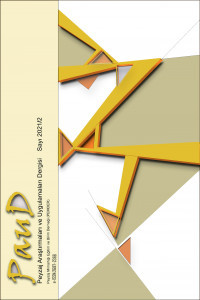KAMUSAL AÇIK YEŞİL ALANLARIN TOPLUMSAL BEKLENTİLER YÖNÜNDEN DEĞERLENDİRİLMESİ:MALTEPE, ORHANGAZİ ŞEHİR PARKI ÖRNEĞİ
Kentlerde giderek önemi artan kentsel açık yeşil alanlar kente ve kentliye pek çok katkı sunmaktadır. Bu alanlardan özellikle parklar, farklı niteliklerdeki insanların bir araya geldiği önemli sosyal ortamlardır ve yine bu alanlar en önemli ögeleri olan insanlar tarafından şekillenmektedir. Bu alanların daha etkin biçimde kullanılabilmesi için, parkların planlanması sırasında ve sonrasında halkın görüş ve isteklerine ulaşmak önemlidir. Her kullanıcıyı memnun edebilmek mümkün olmasa dahi, etkin toplum katılımının sağlanması, gerek demokratik topluluk olmak gerekse sosyal sürdürülebilirliğin sağlanabilmesi açısından önemlidir. Bu çalışmada; kullanıcı odaklı bir yaklaşım kapsamında, Maltepe İlçesi’nde bulunan Orhangazi Şehir Parkı kullanıcıları ile anket çalışması yapılmıştır. Çalışma sonuçlarına göre; kullanıcıların park içi ulaşımda çeşitli sorunlar yaşadığı, donatı elemanları açısından eksiklikler bulunduğu ve fiziksel olarak daha az etkin oldukları aktiviteleri yapmayı tercih ettikleri görülmüştür. Gerçekleştirilen çalışmada, kullanıcı beklentilerinin planlama aşamasında ve sonrasında dikkate alınmasının daha sağlıklı planlama çözümleri gerçekleştirmek açısından önemli bir ölçüt olduğu ortaya konulmuştur.
Anahtar Kelimeler:
Toplumsal beklentiler, Kamusal Açık Yeşil Alan, Katılım
ASSESSMENT OF PUBLIC OPEN GREEN SPACES IN TERMS OF SOCIAL EXPECTATIONS: MALTEPE, ORHANGAZI CITY PARK EXAMPLE
Urban open green spaces, which are becoming increasingly important in cities, brings many benefitsto the city and its citizens. Among these areas, parks are important social environments where people with variouscharacteristics come together and these areas are mostly shaped by people which are the most important elements. Inorder to use these areas more effectively, it is important to reach the views and wishes of the public during and after theplanning and designing of the parks. Even if is not possible to satisfy every user, ensuring effective communityparticipation is important both for being a democratic community and providing social sustainability. In this study; withinthe context of a user-oriented approach, a survey study was conducted with the users of Orhangazi City Park in MaltepeDistrict. It was found that the users experienced various problems in terms of inner circulation in the park, deficienciesrelated to park equipments, and preferred to attend activities in which they can be less physically active. This studydemonstrates that user expectations are crucial criteria for achieving successful planning strategies (solutions).
___
- • Barbosa, O., Tratalos, J. A., Armsworth, P. R., Davies, R. G., Fuller, R. A., Johnson, P., & Gaston, K. J. (2007). Who benefits from access to green space? A case study from Sheffield, UK. Landscape and Urban planning, 83(2-3), 187-195.
- • Bouzguenda, I., Alalouch, C., & Fava, N. (2019). Towards smart sustainable cities: A review of the role digital citizen participation could play in advancing social sustainability. Sustainable Cities and Society, 50, 101627.
- • de Sousa Silva, C., Viegas, I., Panagopoulos, Τ., & Bell, S. (2018). Environmental justice in accessibility to green infrastructure in two European cities. Land, 7(4), 134.
- • Dempsey, N., Bramley, G., Power, S., & Brown, C. (2011). The social dimension of sustainable development: Defining urban social sustainability. Sustainable development, 19(5), 289-300.
- • Fors, H., Molin, J. F., Murphy, M. A., & van den Bosch, C. K. (2015). User participation in urban green spaces–For the people or the parks?. Urban Forestry & Urban Greening, 14(3), 722-734.
- • Hacıalibeyoğlu, F. (2013). Kentsel mekan oluşumunda kullanıcı katılımı. TOBB 2. İzmir Kent Sempozyumu. 185-196.
- • Hughey, S. M., Walsemann, K. M., Child, S., Powers, A., Reed, J. A., & Kaczynski, A. T. (2016). Using an environmental justice approach to examine the relationships between park availability and quality indicators, neighborhood disadvantage, and racial/ethnic composition. Landscape and Urban Planning, 148, 159-169.
- • Likert, R. (1932). A technique for the measurement of attitudes. Archives of psychology.
- • McKenzie, S. (2004). Social sustainability: towards some definitions.
- • Nasution, A. D., & Zahrah, W. (2012). Public open space privatization and quality of life, case study Merdeka Square Medan. Procedia-Social and Behavioral Sciences, 36, 466-475.
- • Özdemir, A. (2009). Katılımcı Kentli Kimliğinin Oluşumunda Kamusal Yeşil Alanların Rolü: Ankara Kent Parkları Örneği. Türkiye Ormancılık Dergisi, 10(1), 144-153.
- • Peschardt K, Schipperijn J, Stigsdotter U (2012). Use of small public open spaces (SPUGS). Urban Forestry&Urban Greening, 11(3), 235-244.
- • Reich, Y., Konda, S. L., Monarch, I. A., Levy, S. N., & Subrahmanian, E. (1996). Varieties and issues of participation and design. Design Studies, 17(2), 165-180.
- • Reyes, M., Páez, A., & Morency, C. (2014). Walking accessibility to urban parks by children: A case study of Montreal. Landscape and Urban Planning, 125, 38-47.
- • Rostami, R., Lamit, H., Khoshnava, S. M., & Rostami, R. (2016). Successful public places: A case study of historical Persian gardens. Urban Forestry & Urban Greening, 15, 211-224.
- • Smiley, K. T., Sharma, T., Steinberg, A., Hodges-Copple, S., Jacobson, E., & Matveeva, L. (2016). More inclusive parks planning: Park quality and preferences for park access and amenities. Environmental Justice, 9(1), 1-7.
- • Tan, P. Y., & Samsudin, R. (2017). Effects of spatial scale on assessment of spatial equity of urban park provision. Landscape and Urban Planning, 158, 139-154.
- • URL 1, 2020, http://www.maltepe.gov.tr/ilcemizin-nufus-durumu (Erişim Tarihi: 30.10.2020)
- • URL 2, 2020, https://webgis.maltepe.bel.tr/keos/ (Erişim Tarihi: 30.10.2020)
- • URL 3, 2020, http://www.anadoluparkbahceler.com/erisilebilirpark.php?epark=Orhangazi%20%C5%9Eehir%20Park%C4%B1&no=26 (Erişim Tarihi: 30.10.2020)
- • Veitch, J., Ball, K., Crawford, D., Abbott, G. R., & Salmon, J. (2012). Park improvements and park activity: a natural experiment. American journal of preventive medicine, 42(6), 616-619.
- • Wang, D., Brown, G., & Liu, Y. (2015). The physical and non-physical factors that influence perceived access to urban parks. Landscape and urban planning, 133, 53-66.
- • Wolch, J. R., Byrne, J., & Newell, J. P. (2014). Urban green space, public health, and environmental justice: The challenge of making cities ‘just green enough’. Landscape and urban planning, 125, 234-244.
- ISSN: 2687-2366
- Yayın Aralığı: Yılda 2 Sayı
- Başlangıç: 2019
- Yayıncı: Peyzaj Mimarlığı Eğitim ve Bilim Derneği
